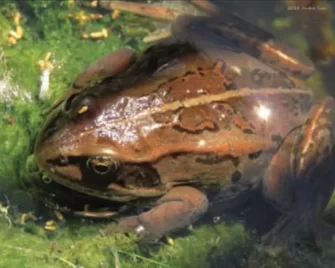
Hoppy Leap year! What better way to celebrate than by taking a closer look at one neighbour known for its outstanding ability to leap thirty times its own body length, the wood frog. In the springtime wood frogs can be recognized by their mating calls from their wetland homes. They make a sound similar to that of rubbing your finger along a balloon; some describe the sound as quack-like. If you follow that sound you might be lucky enough to spot these four- legged amphibians with their tan bodies and dark bandit masks around their eyes. If you do find yourself in this situation, staring down at a handsome spring wood frog, know that you are gazing at one of nature’s hardiest survivors of winter.
The wood frog is the only amphibian that can be found north of the Arctic Circle, giving us cause to contemplate where are they hiding in the cold of February? Underneath Fall’s leaf litter little frogs tucked themselves in as part of their incredible transformation to survive the wicked weather of winter as frozen “frogsicles.”
Freezing is fatal for most organisms because it causes ice crystals to form in the cells. This process can rupture the cell walls, the result being cellular death. To ensure its survival, the wood frog has an incredible adaptation. In the fall it eats as much as it can, building up glycogen in its liver. Then, just before the chilly weather hits, it buries itself in the leaf litter, curls up tight to minimize its surface area and prevent dehydration, and waits as its body temperature drops. It may have the urge to urinate, but the frog will hold in its urine as this becomes a life-saving liquid. When frost or snow touches the frog’s skin the miracle begins. The liver releases massive amounts of glucose (sugars converted from the glycogen) into the bloodstream. This mixes with the urine, creating what is essentially antifreeze. This antifreeze prevents the cells from losing too much liquid, thereby preventing cellular death. With most of its body frozen the lungs stop breathing, the heart stops beating, and brain activity ceases. Any doctor would declare the frog clinically dead, but it has not croaked.
With the warming weather of Spring, the frogsicles melt. The frog thaws in a day or two and off it hops. This extreme survival strategy allows the wood frog to get a jump on life. It does not have to wait for the ice to thaw off the ponds like other frog species, it can start finding a mate early and can catch the groggy insects just emerging. This February 29th I encourage you to emulate a wood frog and hop on the chance to make the most of your extra day.
If you would like to watch this freezing process unfold I suggest watching “Frogsicles: Frozen But Still Alive”, on the Smithsonian Channel on YouTube. Please note this process CANNOT be replicated by throwing a wood frog in a freezer. That would be fatal and is no way to treat our wild neighbours.



























